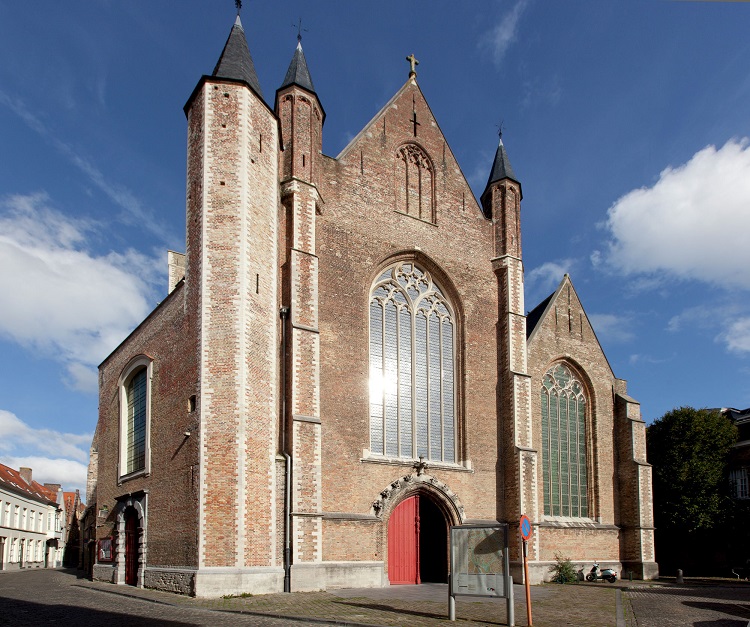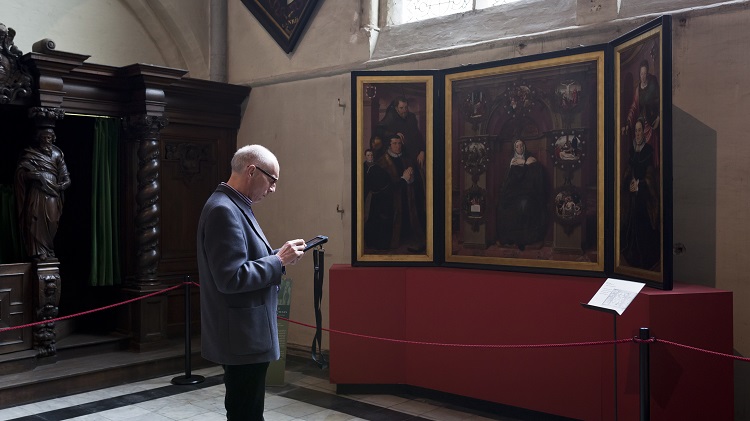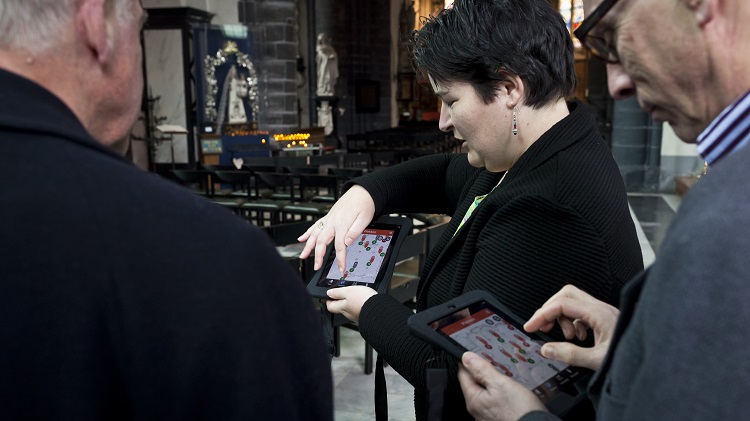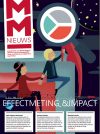
Photo: Fotografische Dienst Stad Brugge Exterior view Sint-Jakobskerk
Bruges is well-known for its historic city centre, recognized as a World Heritage Site by UNESCO in 2000. In late medieval times, it was one of the commercial and cultural centres of Europe, with cultural links to different parts of the world. It has preserved its historic pattern and the original Gothic constructions still form a part of the city’s identity. Its museums, archives and libraries, but also its churches and monasteries still boast an impressive collection of medieval masterpieces, including paintings by the Flemish Primitives and 700 illuminated manuscripts. Today, the city of Bruges counts 120,000 inhabitants and welcomes nearly five million visitors every year.
Religious heritage sites form an important part of the city’s identity. With seven churches, several monasteries, abbeys and chapels, the city centre is densely filled with religious heritage. These magnificent buildings contain a variety of masterpieces, from refined sculptures and silver objects to paintings by the Flemish Primitives and other medieval masters. But that is not all Bruges has to offer. The city still has several religious processions, most notably the Procession of the Holy Blood, which features on UNESCO’s Representative List of Intangible Cultural Heritage.

Photo: Fotografische Dienst Stad Brugge
Sint-Jakobskerk
Beyond the main attractions
The majority of tourists mainly visit three religious heritage sites: the Church of Our Lady, the Basilica of the Holy Blood and the Beguinage with its garden. Of course a visit to Bruges would not be complete without a visit to these sites. But there’s a lot more religious heritage worth seeing. That is why we, at the Heritage Cell of Bruges, asked ourselves the following question: how can we trigger visitors to discover the many treasures that lie hidden in other churches and monasteries?
Lothar Casteleyn:
Half a year later it is clear that visitors are very enthusiastic about the app as a guide for their church visit. Most of them pointed out that they would not have found several important pieces looking around the church by themselves.In 2002, Bruges became the European Capital of Culture. We saw this cultural year as the perfect opportunity to highlight our religious heritage. The city council supported a project to make the seven churches in the city centre accessible to the public on a daily basis. Long-term unemployed people were given the opportunity to become supervisors. For each of the seven churches, a team of four to five people was formed, allowing us to keep the churches open the whole year round. The city council coordinated this project.
When the cultural year ended, the church wardens of these seven churches asked the city council not to shut down the project. Fifteen years later, the system is still up and running. In the summer, the churches are open every morning and every afternoon. In the winter, they are open every afternoon. Every year, each church welcomes between 30,000 and 85,000 people. And the number of visitors continues to grow.
Heritage network
The Heritage Cell Bruges is one of the 22 heritage cells supported by the Flemish government. A heritage cell works in a city or in a cluster of smaller towns with a specific regional heritage. Its aim is to raise awareness of the tangible and intangible heritage in its specific city or region. Heritage cells work together with local organizations that possess a heritage collection, in order to open up these collections to the public. Heritage cells do not own any collections themselves, but rather act as facilitators, stimulating collaboration, helping partners set up new projects, drawing public interest and, where possible, encouraging public participation.

Sint-Jakobskerk
Photo: Fotografische Dienst Stad Brugge
By cooperating with everyone involved in the field of local heritage, heritage cells can offer an experience and knowledge sharing platform that allows professionals to share their expertise with devoted amateurs. This has created a network that has become a breeding ground for active heritage policies and communal projects.
Online pilgrimage
The Heritage Cell Bruges was founded in 2001. One of its first public projects was devoted to religious heritage. In 2003, we made a booklet called Pilgrimage of paintings, in which we linked religious paintings in municipal museums with paintings in historic churches. Several other exhibitions and projects focusing on religious heritage followed in the years after. Throughout the first decade of the 21st century, a lot of images and illustrations of heritage objects were digitally made available. For the city of Bruges, at least 250,000 digital files were created and made public on various websites and tools. With this proliferation of online heritage, we decided it was time to look for new ways to make all these digital files and images available to a broader public. Not only to inhabitants of Bruges, but also all visitors to the city.
We decided to build an app called ‘Xplore Bruges’. By downloading themed routes, museum routes and city walks in the app, visitors can discover the heritage in Bruges in no fewer than five languages (Dutch, French, English, German and Spanish). The app is available on Android and iOS for smartphones and tablets. This project was made possible thanks to the financial support of the Flanders Tourist Office. This coordinating organization promotes Flanders around the world and supports international projects about Flanders. Xplore Bruges was launched in April 2015. By the end of that year, a total of 11 tours were available and the number of downloads had reached 10,000.
Hidden treasures
We soon saw the advantages of the app in highlighting religious heritage sites. A student, who was doing an internship at the Bruges Heritage Cell in 2015, conducted a survey among visitors to three of the lesser visited churches, asking what information they were looking for and what digital means should be used. The student also wrote a first version of the Saint James’s Church tour and tested it together with visitors to the church. The positive feedback given by the test public encouraged us to further develop this tour. A final text edit was made, new photographs were taken and French and English translations were added.

Testers app St Jakobskerk
Photo: Fotografische Dienst Stad Brugge
We also complied with the testers’ wish for a short and long tour. The short tour is built around the five pieces of art on the Flemish government’s List of Masterpieces. This list gives added prestige and protection to the region’s masterpieces. The long tour consists of fifteen stops, allowing users to make a more in-depth visit of the church and to admire objects ranging from the Gothic period to the Renaissance.
The ‘Hidden Rreasures of St. James’s Church’ tour was launched in March of this year. In accordance with the results of the survey and thanks to the subsidies, we were able to buy several tablets that could be used offline in locations for which tours have been developed. From the questionnaire in the survey of our student it was already clear that visitors of the churches would prefer to have tablets there for their use, instead of having to use their own tablet or smartphone.
St.James’s on the map
Half a year later it is clear that visitors are very enthusiastic about the app as a guide for their church visit. Most of them pointed out that they would not have found several important pieces looking around the church by themselves. With an average use of fifteen to thirty minutes, the app proves to be useful for people who are willing to take some time for their visit. The most devoted visitors spent nearly two hours!
It goes without saying that only a small percentage of the visitors are willing to spend so much time. The majority of tourists opt for a quick stroll through the church without the app. This group is not looking for in-depth information, but is there to breathe in the atmosphere while enjoying the silence and looking at the pieces of art.
The success of the ‘Hidden Treasures of St. James’s Church’ tour nevertheless makes it clear that we should invest in indoor tours for more churches in Bruges. With Xplore Bruges we invested in our own app-system, which means that the costs are limited. We have enough information about most churches to make other digital tours. It is important to invest enough time in editing texts for these tours. This means using images as the starting point and writing short sentences to focus on the essence. Less is surely more if you want to reach as many people as possible with your digital tours.
LINK: www.xplorebruges.com.
[Editor MMNieuws:] This article is an adaptation of the autor’s presentation at the Conference on Religious Heritage and Tourism: How to increase religious heritage tourism in a changing society, october 5-7 2016 in Utrecht, The Netherlands.
